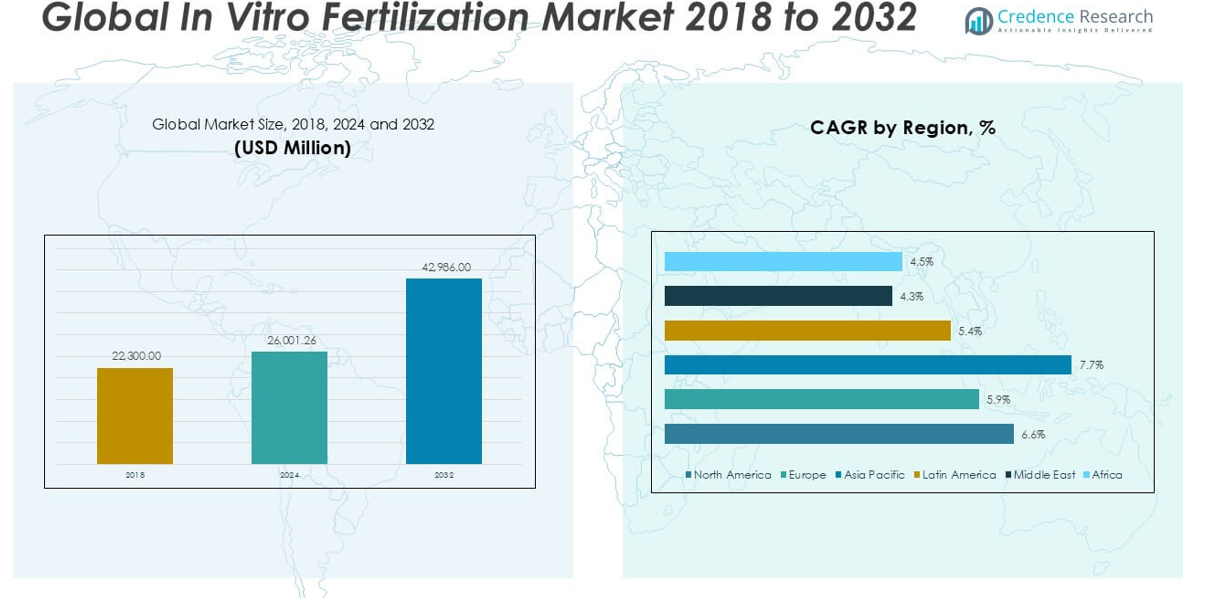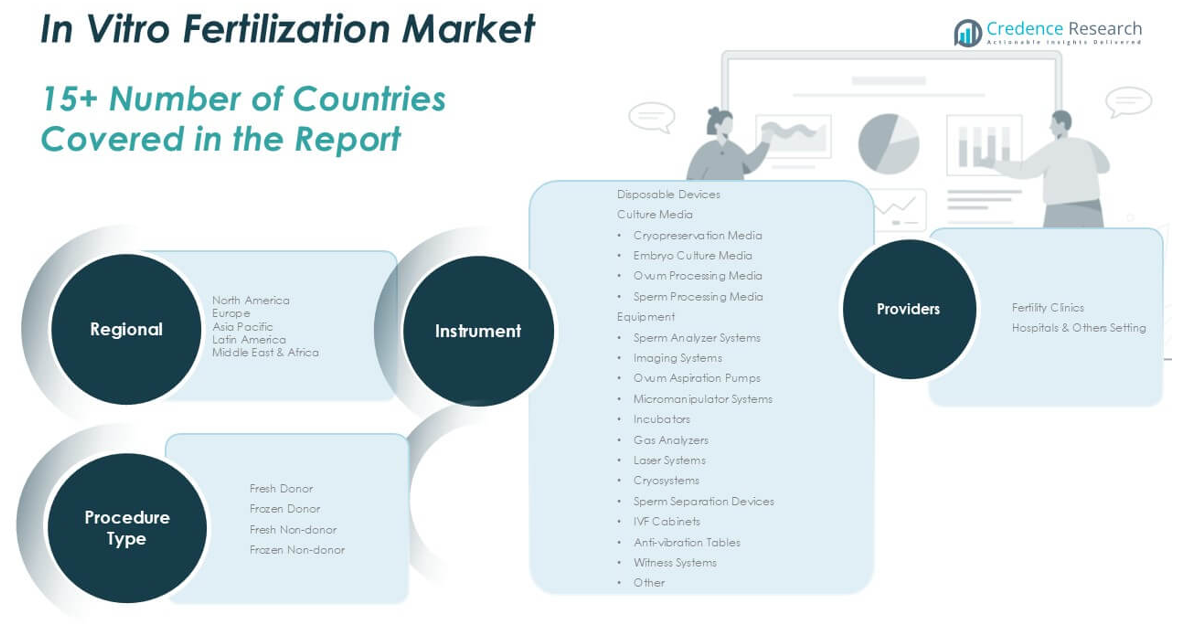CHAPTER NO. 1 : GENESIS OF THE MARKET
1.1 Market Prelude – Introduction & Scope
1.2 The Big Picture – Objectives & Vision
1.3 Strategic Edge – Unique Value Proposition
1.4 Stakeholder Compass – Key Beneficiaries
CHAPTER NO. 2 : EXECUTIVE LENS
2.1 Pulse of the Industry – Market Snapshot
2.2 Growth Arc – Revenue Projections (USD Million)
2.3. Premium Insights – Based on Primary Interviews
CHAPTER NO. 3 : IN VITRO FERTILIZATION MARKET FORCES & INDUSTRY PULSE
3.1 Foundations of Change – Market Overview
3.2 Catalysts of Expansion – Key Market Drivers
3.2.1 Momentum Boosters – Growth Triggers
3.2.2 Innovation Fuel – Disruptive Technologies
3.3 Headwinds & Crosswinds – Market Restraints
3.3.1 Regulatory Tides – Compliance Challenges
3.3.2 Economic Frictions – Inflationary Pressures
3.4 Untapped Horizons – Growth Potential & Opportunities
3.5 Strategic Navigation – Industry Frameworks
3.5.1 Market Equilibrium – Porter’s Five Forces
3.5.2 Ecosystem Dynamics – Value Chain Analysis
3.5.3 Macro Forces – PESTEL Breakdown
3.6 Price Trend Analysis
3.6.1 Regional Price Trend
3.6.2 Price Trend by product
CHAPTER NO. 4 : KEY INVESTMENT EPICENTER
4.1 Regional Goldmines – High-Growth Geographies
4.2 Instrument Frontiers – Lucrative Instrument Categories
4.3 Procedure Type Sweet Spots – Emerging Demand Segments
CHAPTER NO. 5: REVENUE TRAJECTORY & WEALTH MAPPING
5.1 Momentum Metrics – Forecast & Growth Curves
5.2 Regional Revenue Footprint – Market Share Insights
5.3 Segmental Wealth Flow – Instrument & Procedure Type Revenue
CHAPTER NO. 6 : TRADE & COMMERCE ANALYSIS
6.1. Import Analysis by Region
6.1.1. Global In Vitro Fertilization Market Import Revenue By Region
6.2. Export Analysis by Region
6.2.1. Global In Vitro Fertilization Market Export Revenue By Region
CHAPTER NO. 7 : COMPETITION ANALYSIS
7.1. Company Market Share Analysis
7.1.1. Global In Vitro Fertilization Market: Company Market Share
7.2. Global In Vitro Fertilization Market Company Revenue Market Share
7.3. Strategic Developments
7.3.1. Acquisitions & Mergers
7.3.2. New Instrument Launch
7.3.3. Regional Expansion
7.4. Competitive Dashboard
7.5. Company Assessment Metrics, 2024
CHAPTER NO. 8 : IN VITRO FERTILIZATION MARKET – BY INSTRUMENT SEGMENT ANALYSIS
8.1. In Vitro Fertilization Market Overview by Instrument Segment
8.1.1. In Vitro Fertilization Market Revenue Share By Instrument
8.2. Disposable Devices
8.3. Culture Media
8.3.1 Cryopreservation Media
8.3.2 Embryo Culture Media
8.3.3 Ovum Processing Media
8.3.4 Sperm Processing Media
8.4. Equipment
8.4.1 Sperm Analyzer Systems
8.4.2 Imaging Systems
8.4.3 Ovum Aspiration Pumps
8.4.4 Micromanipulator Systems
8.4.5 Incubators
8.4.6 Gas Analyzers
8.4.7 Laser Systems
8.4.8 Cryosystems
8.4.9 Sperm Separation Devices
8.4.10 IVF Cabinets
8.4.11 Anti-vibration Tables
8.4.12 Witness Systems
8.4.13 Other
CHAPTER NO. 9 : IN VITRO FERTILIZATION MARKET – BY PROCEDURE TYPE SEGMENT ANALYSIS
9.1. In Vitro Fertilization Market Overview by Procedure Type Segment
9.1.1. In Vitro Fertilization Market Revenue Share By Procedure Type
9.2. Fresh Donor
9.3. Frozen Donor
9.4. Fresh non-donor
9.5. Frozen non-donor
CHAPTER NO. 10 : IN VITRO FERTILIZATION MARKET – BY PROVIDERS SEGMENT ANALYSIS
10.1. In Vitro Fertilization Market Overview by Providers Segment
10.1.1. In Vitro Fertilization Market Revenue Share By Providers
10.2. Fertility Clinics
10.3. Hospitals & Others Setting
CHAPTER NO. 11 : IN VITRO FERTILIZATION MARKET – REGIONAL ANALYSIS
11.1. In Vitro Fertilization Market Overview by Region Segment
11.1.1. Global In Vitro Fertilization Market Revenue Share By Region
11.1.3. Regions
11.1.4. Global In Vitro Fertilization Market Revenue By Region
.1.6. Instrument
11.1.7. Global In Vitro Fertilization Market Revenue By Instrument
11.1.9. Procedure Type
11.1.10. Global In Vitro Fertilization Market Revenue By Procedure Type
11.1.12. Providers
11.1.13. Global In Vitro Fertilization Market Revenue By Providers
CHAPTER NO. 12 : NORTH AMERICA IN VITRO FERTILIZATION MARKET – COUNTRY ANALYSIS
12.1. North America In Vitro Fertilization Market Overview by Country Segment
12.1.1. North America In Vitro Fertilization Market Revenue Share By Region
12.2. North America
12.2.1. North America In Vitro Fertilization Market Revenue By Country
12.2.2. Instrument
12.2.3. North America In Vitro Fertilization Market Revenue By Instrument
12.2.4. Procedure Type
12.2.5. North America In Vitro Fertilization Market Revenue By Procedure Type
2.2.6. Providers
12.2.7. North America In Vitro Fertilization Market Revenue By Providers
2.3. U.S.
12.4. Canada
12.5. Mexico
CHAPTER NO. 13 : EUROPE IN VITRO FERTILIZATION MARKET – COUNTRY ANALYSIS
13.1. Europe In Vitro Fertilization Market Overview by Country Segment
13.1.1. Europe In Vitro Fertilization Market Revenue Share By Region
13.2. Europe
13.2.1. Europe In Vitro Fertilization Market Revenue By Country
13.2.2. Instrument
13.2.3. Europe In Vitro Fertilization Market Revenue By Instrument
13.2.4. Procedure Type
13.2.5. Europe In Vitro Fertilization Market Revenue By Procedure Type
13.2.6. Providers
13.2.7. Europe In Vitro Fertilization Market Revenue By Providers
13.3. UK
13.4. France
13.5. Germany
13.6. Italy
13.7. Spain
13.8. Russia
13.9. Rest of Europe
CHAPTER NO. 14 : ASIA PACIFIC IN VITRO FERTILIZATION MARKET – COUNTRY ANALYSIS
14.1. Asia Pacific In Vitro Fertilization Market Overview by Country Segment
14.1.1. Asia Pacific In Vitro Fertilization Market Revenue Share By Region
14.2. Asia Pacific
14.2.1. Asia Pacific In Vitro Fertilization Market Revenue By Country
14.2.2. Instrument
14.2.3. Asia Pacific In Vitro Fertilization Market Revenue By Instrument
14.2.4. Procedure Type
14.2.5. Asia Pacific In Vitro Fertilization Market Revenue By Procedure Type
14.2.5. Providers
14.2.7. Asia Pacific In Vitro Fertilization Market Revenue By Providers
14.3. China
14.4. Japan
14.5. South Korea
14.6. India
14.7. Australia
14.8. Southeast Asia
14.9. Rest of Asia Pacific
CHAPTER NO. 15 : LATIN AMERICA IN VITRO FERTILIZATION MARKET – COUNTRY ANALYSIS
15.1. Latin America In Vitro Fertilization Market Overview by Country Segment
15.1.1. Latin America In Vitro Fertilization Market Revenue Share By Region
15.2. Latin America
15.2.1. Latin America In Vitro Fertilization Market Revenue By Country
15.2.2. Instrument
15.2.3. Latin America In Vitro Fertilization Market Revenue By Instrument
15.2.4. Procedure Type
15.2.5. Latin America In Vitro Fertilization Market Revenue By Procedure Type
15.2.6. Providers
15.2.7. Latin America In Vitro Fertilization Market Revenue By Providers
15.3. Brazil
15.4. Argentina
15.5. Rest of Latin America
CHAPTER NO. 16 : MIDDLE EAST IN VITRO FERTILIZATION MARKET – COUNTRY ANALYSIS
16.1. Middle East In Vitro Fertilization Market Overview by Country Segment
16.1.1. Middle East In Vitro Fertilization Market Revenue Share By Region
16.2. Middle East
16.2.1. Middle East In Vitro Fertilization Market Revenue By Country
16.2.2. Instrument
16.2.3. Middle East In Vitro Fertilization Market Revenue By Instrument
16.2.4. Procedure Type
16.2.5. Middle East In Vitro Fertilization Market Revenue By Procedure Type
16.2.6. Providers
16.2.7. Middle East In Vitro Fertilization Market Revenue By Providers
16.3. GCC Countries
16.4. Israel
16.5. Turkey
16.6. Rest of Middle East
CHAPTER NO. 17 : AFRICA IN VITRO FERTILIZATION MARKET – COUNTRY ANALYSIS
17.1. Africa In Vitro Fertilization Market Overview by Country Segment
17.1.1. Africa In Vitro Fertilization Market Revenue Share By Region
17.2. Africa
17.2.1. Africa In Vitro Fertilization Market Revenue By Country
17.2.2. Instrument
17.2.3. Africa In Vitro Fertilization Market Revenue By Instrument
17.2.4. Procedure Type
17.2.5. Africa In Vitro Fertilization Market Revenue By Procedure Type
17.2.6. Providers
17.2.7. Africa In Vitro Fertilization Market Revenue By Providers
17.3. South Africa
17.4. Egypt
17.5. Rest of Africa
CHAPTER NO. 18 : COMPANY PROFILES
18.1. Bayer AG
18.1.1. Company Overview
18.1.2. Instrument Portfolio
18.1.3. Financial Overview
18.1.4. Recent Developments
18.1.5. Growth Strategy
18.1.6. SWOT Analysis
18.2. Cook Medical LLC
18.3. EMD Serono, Inc.
18.4. Ferring B.V.
18.5. FUJIFILM Irvine Scientific (FUJIFILM Holdings Corporation)
18.6. Genea Biomedx
18.7. EMD Serono, Inc. (Merck KGaA)
18.8. Merck KGaA (Germany)
18.9. The Cooper Companies, Inc.
18.10. Thermo Fisher Scientific, Inc.
18.11. Vitrolife
18.12. Boston IVF
18.13. Nova IVF
18.14. RMA Network (Reproductive Medicine Associates)
18.15. TFP Thames Valley Fertility
18.16. Fortis Healthcare
18.17. U.S. Fertility





